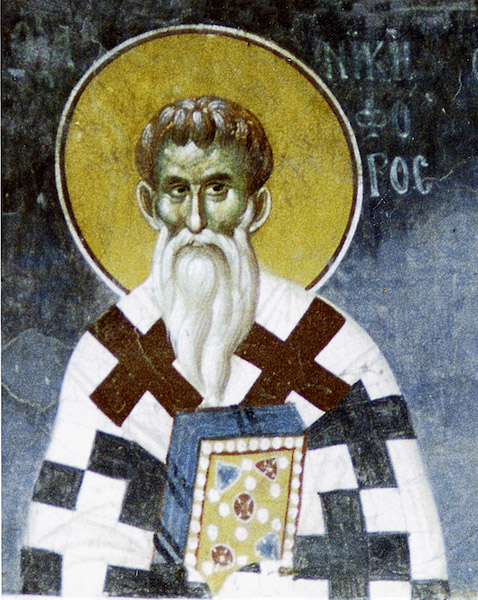Nikephoros the Confessor, Patriarch of Constantinople (2 June)

Saint Nikēphóros was a dignitary at the court of the Empress Irene (797-802). After embracing monasticism, he became widely known for his piety. He assumed the Patriarchal Throne of Constantinople in 806 and became a zealous defender of the holy Icons. In 815, the Iconoclast Emperor Leo the Armenian (813-820) exiled him to Prokonnis, where he fell asleep in the Lord in 828. Saint Nikēphóros left behind three writings against Iconoclasm.
In 846, the relics of Patriarch Nikēphóros were returned to Constantinople and placed in the Great Church of Hagia Sophia for one day before being transferred to and enshrined in the Church of the Holy Apostles.
Saint Nicephorus was born in Constantinople about the year 758, of pious parents; his father Theodore endured exile and tribulation for the holy icons during the reign of Constantine Copronymus (741-775). Nicephorus served in the imperial palace as a secretary. Later, he took up the monastic life, and struggled in asceticism not far from the imperial city; he also founded monasteries on the eastern shore of the Bosphorus, among them one dedicated to the Great Martyr Theodore.
 After the repose of the holy Patriarch Tarasius, he was ordained Patriarch, on April 12, 806, and in this high office led the Orthodox resistance to the Iconoclasts’ war on piety, which was stirred up by Leo the Armenian. Because Nicephorus championed the veneration of the icons, Leo drove Nicephorus from his throne on March 13, 815, exiling him from one place to another, and lastly to the Monastery of Saint Theodore which Nicephorus himself had founded. It was here that, after glorifying God for nine years as Patriarch, and then for thirteen years as an exile, tormented and afflicted, he gave up his blameless soul in 828 at about the age of seventy. See also March 8.
After the repose of the holy Patriarch Tarasius, he was ordained Patriarch, on April 12, 806, and in this high office led the Orthodox resistance to the Iconoclasts’ war on piety, which was stirred up by Leo the Armenian. Because Nicephorus championed the veneration of the icons, Leo drove Nicephorus from his throne on March 13, 815, exiling him from one place to another, and lastly to the Monastery of Saint Theodore which Nicephorus himself had founded. It was here that, after glorifying God for nine years as Patriarch, and then for thirteen years as an exile, tormented and afflicted, he gave up his blameless soul in 828 at about the age of seventy. See also March 8.
Nicephorus was a nobleman of Constantinople. His father, Theodore, a high-ranking official of the imperial court, was wealthy and pious. Nicephorus served at the court for several years in the same profession as his father. Seeing all the vanity of the world, he withdrew to the shores of the Bosphorus and founded a monastery. The monastery was quickly filled with monks and he governed it; but he was not willing to receive the monastic tonsure, under the pretext that he was not worthy, even though in all things he served as a model to all.
Before that, he had participated in the Seventh Ecumenical Council [Nicea, 787 A.D.] as a layman, at the wishes of the emperor and the patriarch, and the Council had benefited greatly by his superior knowledge of Sacred Scripture. When Patriarch Tarasius died, Nicephorus was elected patriarch against his will. Immediately following his election in the year 806 A.D., he received the monastic tonsure and, in succession, all the ecclesiastical ranks.
He was enthroned as patriarch in the Church of the Divine Wisdom of God [Hagia Sophia]. This took place during the reign of Emperor Nicephorus, who immediately after that went to war against the Bulgarians and was slain. His son Stauracius reigned only two months and died. After him there ruled the good Emperor Michael, surnamed Rangabe, but he reigned for only two years, until he was overthrown by Leo the Armenian and banished into exile. When Leo was to be crowned, the patriarch sent him a book of the Orthodox Confession of Faith to sign (according to the custom of all Byzantine emperors which was considered an oath that they would uphold and defend the True Faith).
The emperor did not sign it but rather postponed signing it until after the coronation. When the patriarch crowned him, Leo refused to sign the book, and he quickly proved himself to be a heretic, an iconoclast. The patriarch attempted to advise him and restore him to the True Faith, but in vain. The emperor forcibly banished Nicephorus to the island of Proconnesus, where he remained for thirteen years, enduring every kind of misery and privation, and he entered into eternity in the year 827 A.D. He governed the Church of Christ as patriarch for nine years.
Apolytikion of Nicephorus, Abp. of Constantinople
Fourth Tone
A model of faith and the image of gentleness, the example of your life has shown you forth to your sheep-fold to be a master of temperance. You obtained thus through being lowly, gifts from on high, and riches through poverty. Nicephorus, our father and priest of priests, intercede with Christ our God that He may save our souls.
Kontakion of Nicephorus, Abp. of Constantinople
Fourth Tone
Since thou hast received today the crown of vict’ry from the Heavens at God’s hand, save all them that faithfully now honour thee as a teacher and a faithful hierarch, O Father Nicephorus.
Source: oca.org / goarch.org / westserbdio.org





